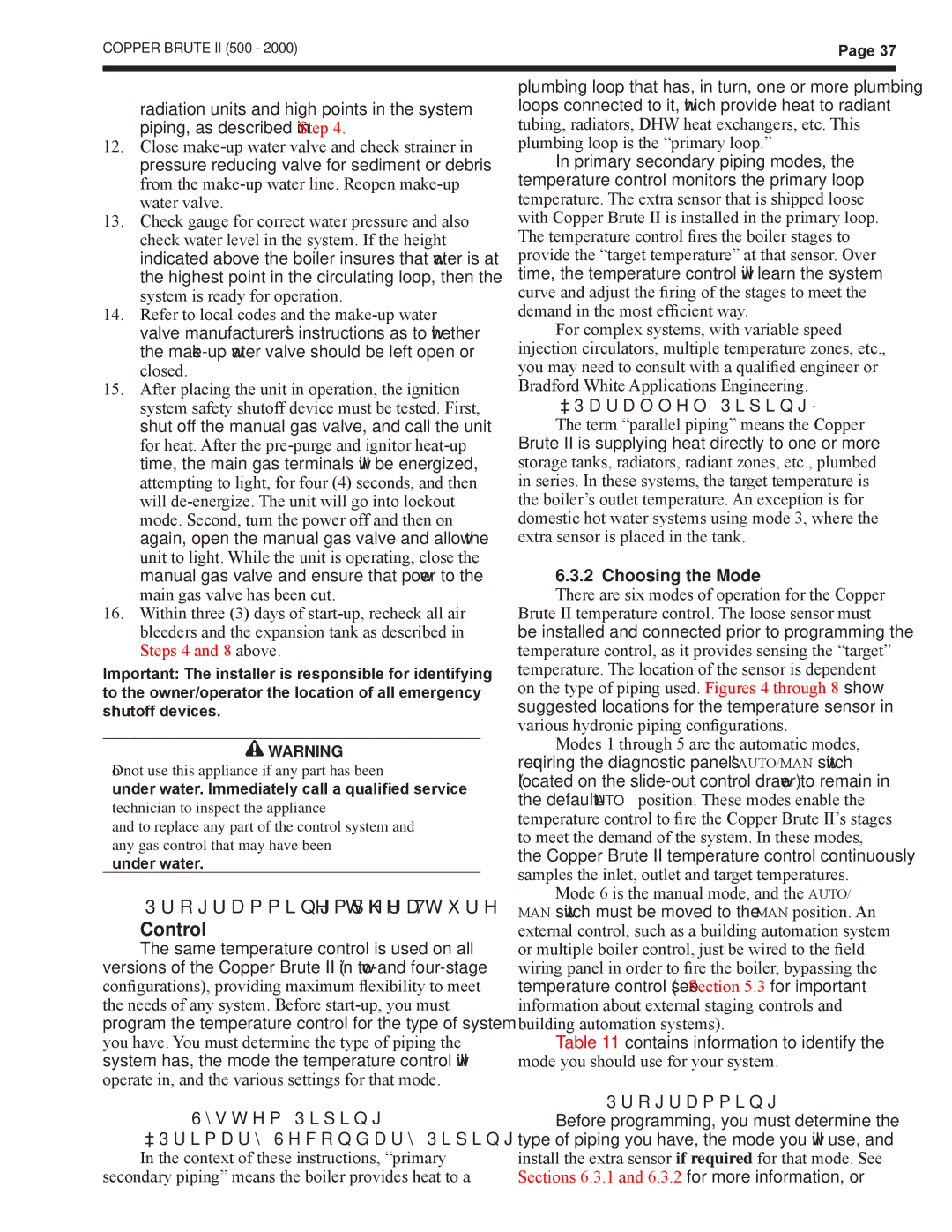
COPPER BRUTE II (500 - 2000) | Page 37 |
radiation units and high points in the system piping, as described in Step 4.
12.Close
13.Check gauge for correct water pressure and also check water level in the system. If the height indicated above the boiler insures that water is at the highest point in the circulating loop, then the system is ready for operation.
14.Refer to local codes and the
15.After placing the unit in operation, the ignition system safety shutoff device must be tested. First, shut off the manual gas valve, and call the unit for heat. After the
16.Within three (3) days of
Important: The installer is responsible for identifying to the owner/operator the location of all emergency shutoff devices.
![]() WARNING
WARNING
Do not use this appliance if any part has been under water. Immediately call a qualified service technician to inspect the appliance
and to replace any part of the control system and any gas control that may have been
under water.
6.3 Programming the Temperature
Control
The same temperature control is used on all versions of the Copper Brute II (in
6.3.1System Piping “Primary Secondary Piping”
In the context of these instructions, “primary
secondary piping” means the boiler provides heat to a
plumbing loop that has, in turn, one or more plumbing loops connected to it, which provide heat to radiant tubing, radiators, DHW heat exchangers, etc. This plumbing loop is the “primary loop.”
In primary secondary piping modes, the temperature control monitors the primary loop temperature. The extra sensor that is shipped loose with Copper Brute II is installed in the primary loop. The temperature control fires the boiler stages to provide the “target temperature” at that sensor. Over time, the temperature control will learn the system curve and adjust the firing of the stages to meet the demand in the most efficient way.
For complex systems, with variable speed injection circulators, multiple temperature zones, etc., you may need to consult with a qualified engineer or Bradford White Applications Engineering.
“Parallel Piping”
The term “parallel piping” means the Copper Brute II is supplying heat directly to one or more storage tanks, radiators, radiant zones, etc., plumbed in series. In these systems, the target temperature is the boiler’s outlet temperature. An exception is for domestic hot water systems using mode 3, where the extra sensor is placed in the tank.
6.3.2 Choosing the Mode
There are six modes of operation for the Copper Brute II temperature control. The loose sensor must be installed and connected prior to programming the temperature control, as it provides sensing the “target” temperature. The location of the sensor is dependent on the type of piping used. Figures 4 through 8 show suggested locations for the temperature sensor in various hydronic piping configurations.
Modes 1 through 5 are the automatic modes, requiring the diagnostic panel’s AUTO/MAN switch (located on the
Mode 6 is the manual mode, and the AUTO/ MAN switch must be moved to the MAN position. An external control, such as a building automation system or multiple boiler control, just be wired to the field wiring panel in order to fire the boiler, bypassing the temperature control (see Section 5.3 for important information about external staging controls and building automation systems).
Table 11 contains information to identify the mode you should use for your system.
6.3.3 Programming
Before programming, you must determine the type of piping you have, the mode you will use, and install the extra sensor if required for that mode. See Sections 6.3.1 and 6.3.2 for more information, or
